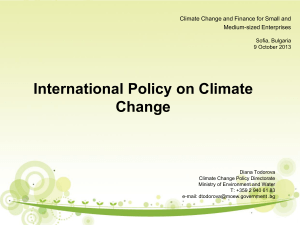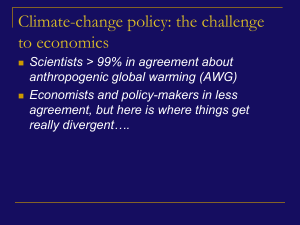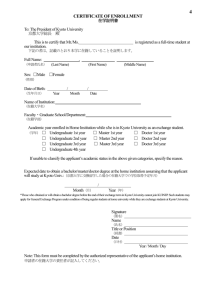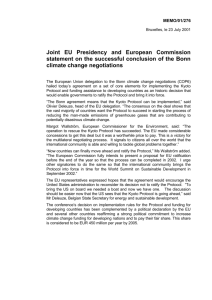Climate Change Diplomacy: The Next Step
advertisement
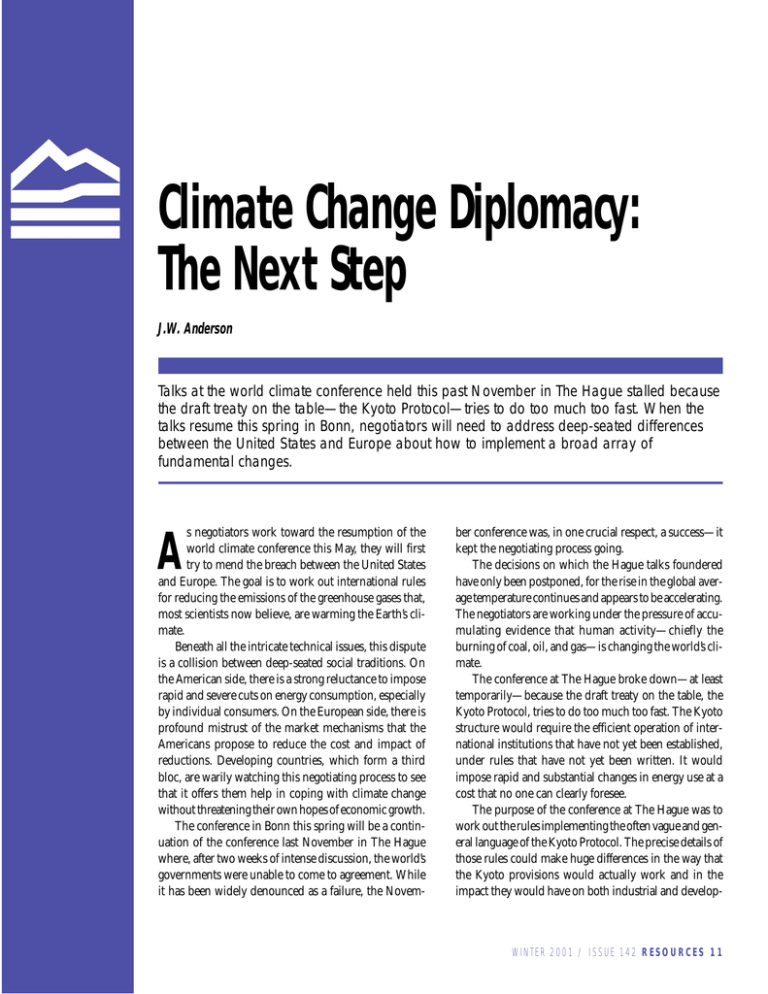
Climate Change Diplomacy: The Next Step J.W. Anderson Talks at the world climate conference held this past November in The Hague stalled because the draft treaty on the table—the Kyoto Protocol—tries to do too much too fast. When the talks resume this spring in Bonn, negotiators will need to address deep-seated differences between the United States and Europe about how to implement a broad array of fundamental changes. s negotiators work toward the resumption of the world climate conference this May, they will first try to mend the breach between the United States and Europe. The goal is to work out international rules for reducing the emissions of the greenhouse gases that, most scientists now believe, are warming the Earth’s climate. Beneath all the intricate technical issues, this dispute is a collision between deep-seated social traditions. On the American side, there is a strong reluctance to impose rapid and severe cuts on energy consumption, especially by individual consumers. On the European side, there is profound mistrust of the market mechanisms that the Americans propose to reduce the cost and impact of reductions. Developing countries, which form a third bloc, are warily watching this negotiating process to see that it offers them help in coping with climate change without threatening their own hopes of economic growth. The conference in Bonn this spring will be a continuation of the conference last November in The Hague where, after two weeks of intense discussion, the world’s governments were unable to come to agreement. While it has been widely denounced as a failure, the Novem- A ber conference was, in one crucial respect, a success—it kept the negotiating process going. The decisions on which the Hague talks foundered have only been postponed, for the rise in the global average temperature continues and appears to be accelerating. The negotiators are working under the pressure of accumulating evidence that human activity—chiefly the burning of coal, oil, and gas—is changing the world’s climate. The conference at The Hague broke down—at least temporarily—because the draft treaty on the table, the Kyoto Protocol, tries to do too much too fast. The Kyoto structure would require the efficient operation of international institutions that have not yet been established, under rules that have not yet been written. It would impose rapid and substantial changes in energy use at a cost that no one can clearly foresee. The purpose of the conference at The Hague was to work out the rules implementing the often vague and general language of the Kyoto Protocol. The precise details of those rules could make huge differences in the way that the Kyoto provisions would actually work and in the impact they would have on both industrial and develop- WINTER 2001 / ISSUE 142 RESOURCES 11 RESOURCES FOR THE FUTURE ing economies. With those rules remaining in doubt, no major ing countries. The Kyoto text promises to facilitate the transfer industrial country has yet ratified Kyoto. Supporters of the treaty, of clean technologies to them and to provide aid to help them especially in Europe, had hoped that this conference would result adapt to climate change and develop the capacity to track their own emissions. But the developing countries want to know in the Kyoto treaty’s going into force in 2002. That would require exactly how much money will be provided and how it will be ratification by at least 55 countries, including countries that in allocated—by whom and under what conditions. During the 1990 produced 55% of the industrial countries’ emissions of carconference, the United States and several other countries probon dioxide, the most important of the greenhouse gases. posed a new fund of $1 billion a year to help poor countries The issues in the next round could be somewhat different, cope with climate change, but this idea was never clearly defined. for the negotiators will soon have to acknowledge that there may Even if the Americans and the Europeans had managed to not be enough time, as a matter of practical politics, to meet the goals and timetables set down in the present Kyoto text. As it work out an eleventh-hour deal on sinks, the long list of unrenow stands, Kyoto would impose binding limits on the emissolved issues concerning the developing countries would have sions of industrialized countries beginning prevented any final agreement on the in 2008, requiring deep cuts in many counKyoto text. tries, including the United States. Pronk’s second category of open issues As the conference at The Hague ended was sinks. The primary question is how While the conference at much credit a country ought to get for its on a note of dissonance, negotiators told The Hague was a setback, land use and forestry practices. The disthe press that it had been moving toward the longer future looks pute here came to dominate the public agreement until, at the last moment, a compromise on “sinks” fell apart. (Sinks are the more hopeful. Throughout discussion during the closing days of the repositories in which natural processes the world, public opinion is November conference. The United States store carbon; growing plants, including argued that it would need rules giving it taking note of the wide access to credits for its sinks in order trees, and soils are considered carbon accumulating evidence of to meet the large reductions from busisinks.) This is a puzzling claim, because global warming. ness-as-usual emissions trends that Kyoto apart from sinks there is a long list of issues that one party or another considers crucial would impose. Without those credits for and that remain unresolved. sinks, the U.S. negotiators declared, they would never have agreed to Kyoto in the ‘Crunch’ Issues for Negotiators first place. But the European governments, and environmental In the United States, the Clinton administration has said that it organizations on both sides of the Atlantic, denounced the Amerwill not send a climate treaty to the Senate for a vote on ratifiican proposal as a gigantic loophole that would undercut the cation unless it provides for “meaningful participation” by the integrity of the whole Kyoto regime. larger developing countries. The present Kyoto text puts no Sinks, the most arcane of the major issues, are well underlegal limits on the greenhouse gas emissions of the developing stood only by the specialists. For that reason a disagreement here countries. While there was discussion at The Hague of the develis, as a matter of politics, more easily repaired than, say, an ideoping countries’ role, the question of what might constitute ological breach between the developed and developing countries, meaningful participation never came into focus. Similarly, the or a public quarrel between the United States and Europe over Clinton administration has said that it wants explicit rules on what the European Greens see as American consumers’ wasteinternational trading of emissions permits before it ratifies, but ful and destructive habits. (France’s President Jacques Chirac the trading rules also remain unclear. tried to open that subject when he addressed the conference, Jan Pronk, the Dutch minister of the environment and presbut none of the negotiators pursued it.) ident of the conference, outlined early in the talks four clusters The third cluster in Pronk’s list was the Kyoto mechanisms— of what he called “crunch” issues. the trading of emissions permits and the two programs, Joint The first were the issues of greatest interest to the developImplementation and the Clean Development Mechanism, which 12 RESOURCES WINTER 2001 / ISSUE 142 RESOURCES FOR THE FUTURE would permit one country to earn additional emissions permits by investing in reductions in another country. Progress is being made in understanding and developing the technical procedures for these mechanisms, but a number of fundamental policy questions remain unanswered. Chief among them is the issue of supplementarity—the extent to which a country can buy permits abroad to supplement its domestic action to cut emissions. The Europeans entered the negotiations arguing that, on principle, no country should be allowed to buy permits to cover the bulk of its required reductions. The United States replied that it doesn’t see why a country shouldn’t buy as much as it wants, if cuts are cheaper overseas than at home. That’s another one that remains unresolved. Pronk’s fourth category of “crunch” issues involved compliance—how to measure it and how to enforce it. Here again the November conference supplied no clear answers. Because complying in good faith with the Kyoto targets for emissions reduction will impose substantial costs on industrial economies, quite possibly affecting the terms of international trade, governments are likely to want assurance that their competitors can’t simply ignore their commitments. The Kyoto text makes no provision for enforcement. During the talks, Pronk himself at one point proposed that a country’s shortfall in emissions reductions in one five-year commitment period should be added to its reduction target in the next, with a penalty of an additional reduction. But that invites the question why a country, once in default, might not simply continue rolling up shortfalls and penalties or refuse to accept tighter future targets in the negotiations. Until there’s a persuasive answer to that question, the U.S. Senate is unlikely to proceed with ratification. Changing Circumstances The high hopes for the November conference—that it could resolve enough of these issues to result in widespread ratification and entry into force of the treaty within two years—were probably unrealistic from the beginning. When the date for the conference was first set, a year earlier, the Americans warned that it would fall in the lame-duck period after the U.S. presidential election. While no one could have foreseen the degree of confusion that in fact followed the election, it would have been a very difficult time for the United States to negotiate effec- tively in any case. The Europeans brushed those warnings aside and, over American protests, went ahead with a conference as scheduled. It appeared that some Europeans saw the conference as an opportunity for European governments to show leadership and initiative. That prospect changed suddenly in September, with the furious public protests throughout western Europe to the rising prices of gasoline and oil. Governments were thrown on the defensive. The French government immediately gave truckers a substantial cut in fuel taxes, and, before long, the British promised to do the same. With that, the prospect of any broad surtaxes or restrictions on fuel use evaporated. With neither the Europeans nor the Americans capable of taking the lead in a serious attempt to reduce emissions, the prospects for a comprehensive agreement on climate change began to fade well before the conference opened. The public quarreling among several of the European ministers, as the conference ended, also suggested that any common strategy within the European Union had broken down. Looking Ahead But while the conference at The Hague was a setback, the longer future looks more hopeful. Throughout the world, public opinion is increasingly taking note of the accumulating evidence of global warming. References to warming are becoming frequent in news accounts of storms and droughts, for example. In developing countries, officials are beginning to consider the possibility that a world climate agreement might not be merely a crude attempt to cut off their economic growth, but rather a possible source of help in dealing with the air pollution that is emerging as a major menace to public health. Progress toward a world climate agreement is likely to be incremental, not the sudden dramatic leap that the Kyoto Protocol’s supporters had hoped. But there was some slow progress at The Hague, and there is likely to be more when the conference resumes in Bonn this May. Should a final agreement ever be reached, it is quite likely to be very different from the present Kyoto text. What counts is whether the world can work out a long-term response to a threat that will rise gradually through the coming century. J.W. Anderson is journalist-in-residence at RFF. WINTER 2001 / ISSUE 142 RESOURCES 13


